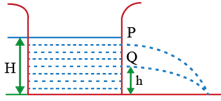Question
A cylindrical vessel is filled with water to a height H. A vessel has two holes in the side, from which water is rushing out horizontally and two streams strike at the same point. If the lower hole Q is h height abve the ground, then the height of hole P above the ground will be :
Solution
Correct option is
H – h
Let the horizontal distance covered by the stream be x

and 

In this time, the horizontal distance for



Similarly for 


SIMILAR QUESTIONS
Q1
A horizontal tube has different cross-sectional areas at points A and B. The diameter of A is 4 cm and that of B is 2 cm. Two manometer limbs are attached at A and B. When a liquid of density 0.8 g/cm3 flows through the tube, the pressure-difference between the limbs of the manometer is 8 cm. calculate the rate of flow of the liquid in the tube. (g = 980 cm/s2)
Q2
Find out the velocity of efflux of water from a hole in the wall of a tank made at 20 m below the free surface of water in the tank.
g = 10 m/s2.
Q3
Water tank has a hole in its wall at a distance of 10 m below the free surface of water. The diameter of the hole is 2 mm. Compute the velocity of efflux of water from the hole and the rate of flow of water. (g = 9.8 m/s2)
Q4
S1 and S2 are spring balances. A block A is hanging from spring balanceS1 and immersed in a liquid L which is contented a beaker B. The mass of beaker B is 1 kg and the mass of liquid L is 1.5 kg. The S1 and S2balances reads 2.5 kg and 7.5 kg respectively. What will be the reading ofS1 and S2 when the block A is pulled up out of the liquid :
Q5
Air is blow through a pipe AB at a rate of 15 liter per minute. The cross section area of the wide portion of the pipe AB is 2 cm2 and that of the narrow potion is 0.5 cm? the difference in the water level h is : 
Q6
Water from a tap emerge vertically downward with a initial speed of 1 m/s. The cross section area of the tap is 10–4 m2. Assume that the pressure is constant throughout the stream of water and that the flow steady. The cross section area of the stream 0.15 m below the tap is :
Q7
A pipe GB is fitted with two pipes C and D. The pipe has area A = 24 m2at G and velocity of water at G is 10 m/s and at C is 10 m/s the velocity of water D is
Q8
A non viscous liquid of constant density 500 kg/m2 flows in a variable cross-sectional tube. The area of cross section of the tube at two points Pand Q at height of 3 m and 6 m are  and
and  respectively. The work done per unit volume by the force of gravity as the fluid flows from point P and Q is
respectively. The work done per unit volume by the force of gravity as the fluid flows from point P and Q is
Q9
Water flows along a horizontal pipe whose cross section is not constant. The pressure is 1 cm of Hg where the velocity is 35 cm/s. At a point where the velocity is 65 cm/s. At a point where the velocity is 65 cm/s, the pressure will be:
Q10
There is a wide tank of cross-section area A contain a liquid to a height Hhas a small orifice at its base of area 'a' (a < < A). The time during which liquid level falls to a height 














